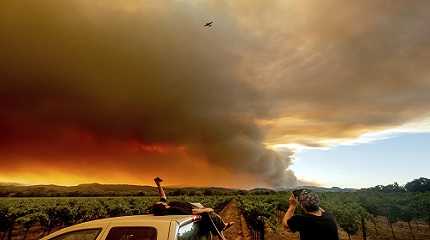
MILAN, July 20 (Reuters) - Fire brigades in Tuscany on Wednesday battled for a second day to control a wildfire that has forced hundreds to evacuate, while a blaze in northeast Italy spread to Slovenia and threatened to leave the city of Trieste without power and water.
Wildfires have broken out in several parts of Italy this week as temperatures keep rising.
Nine cities were on the country's highest heatwave alert, which warns of serious health risks linked to the weather, up from five on Tuesday. The total is expected to rise to 14 on Thursday, including Rome, Milan and Florence, and 16 on Friday.
Temperatures are forecast to hit 40 degrees Celsius (104 degrees Fahrenheit)across a swathe of the north and centre this week, as well as in Puglia in the south and the islands of Sardinia and Sicily.
On Wednesday, a fire that broke out on Monday evening near the Tuscan town of Lucca continued to burn, having already destroyed some 650 hectares (2.5 square miles) of woods.
It forced around 300 people to evacuate as the flames raged through the night reaching some villages and causing some liquefied gas tanks to explode, the region's governor Eugenio Giani said on Twitter.
"Some fronts have strengthened because of the wind," Giani said. "We're aiming to contain the fire within a set area by tonight when (helicopters and Canadair water bombers) stop flying."
Meanwhile the northeastern Friuli Venezia Giulia local administration prepared to widen to the entire region a fire alert after a blaze that started on Tuesday in the Carso area bordering Croatia and Slovenia.
Residents were urged to stay indoors on Wednesday because of the heavy smoke and state-owned shipbuilder Fincantieri (FCT.MI) closed down a plant employing 3,000 in the Adriatic port city of Monfalcone.
As the fire crossed the border into Slovenia, the residents of four villages seen at risk from the flames have been urged to leave their homes, Italian media reported.
Trieste mayor Roberto Dipiazza told a local television channel that parts of the city of around 200,000 people could soon stop receiving electricity, without specifying why, and that this would affect water supply because pumps would not be able to function.




